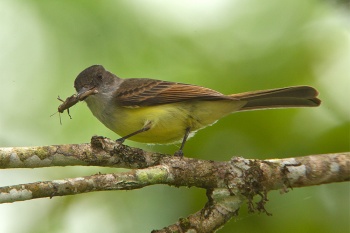
Photo by Stanley Jones
Silanche Bird Sanctuary near Mindo, Ecuador, December, 2007
- Myiarchus tuberculifer
Identification
A small Myiarchus (15–17 cm; 6-6¾ in)
- Bushy crest
- Brownish-black crown
- Dull, dark olive upperparts
- Dull whitish edges to the wing coverts and a hint of rufous on the edge of the primaries
- Dark brown tail with no rufous edging
Variations
The color of the crown and sides of head varies among subspecies with especially northern birds brownish (or sometimes brownish-grey) while South American populations usually are blacker.
Distribution
Southern Arizona and southwestern corner of New Mexico; Mexico south to northern half of South America.
Rare but regular vagrant to California.
Accidental to casual vagrant in Nevada, Colorado, Texas, and Oklahoma.
Taxonomy
Subspecies
There are thirteen recognized subspecies[1]:
- M. t. olivascens: South-western US and north-western Mexico; winters to Oaxaca
- M. t. lawrenceii: Eastern Mexico (Nuevo León) to highlands of Guatemala
- M. t. querulus: South-western Mexico (southern Sinaloa to Oaxaca); Tres Marias Islands
- M. t. platyrhynchus: Cozumel Island (off Yucatan Peninsula of eastern Mexico)
- M. t. manens: South-eastern Mexico (southern Yucatan Peninsula)
- M. t. connectens: Guatemala to northern Nicaragua
- M. t. littoralis: Pacific coast of south-eastern Honduras to north-western Costa Rica
- M. t. nigricapillus: Extreme south-eastern Nicaragua to Costa Rica and western Panama
- M. t. brunneiceps: Tropical eastern Panama and western Colombia
- M. t. pallidus: Northern Colombia to northern and western Venezuela
- M. t. tuberculifer: Eastern Colombia to Suriname and Amazonian Brazil; south-eastern Brazil; Trinidad
- M. t. nigriceps: South-western Colombia to western Ecuador and north-western Peru
- M. t. atriceps: Eastern slope of Andes of Ecuador to eastern Peru, Bolivia and north-western Argentina
Habitat
A wide variety of habitats from forest and forest edges to secondary growth and disturbed habitat.
Behaviour
Diet
The diet consists of many insects, such as grasshoppers, termites, mayflies, flies and damselflies. With fruits added in the winter.
Breeding
They nest in a tree cavity. The 3 buff eggs are marked with brown. The young fledge after 13 days.
References
- Clements, J. F., T. S. Schulenberg, M. J. Iliff, D. Roberson, T. A. Fredericks, B. L. Sullivan, and C. L. Wood. 2016. The eBird/Clements checklist of birds of the world: v2016, with updates to August 2016. Downloaded from http://www.birds.cornell.edu/clementschecklist/download/
- Arthur Grosset
- Wikipedia
Recommended Citation
- BirdForum Opus contributors. (2025) Dusky-capped Flycatcher. In: BirdForum, the forum for wild birds and birding. Retrieved 11 May 2025 from https://www.birdforum.net/opus/Dusky-capped_Flycatcher
External Links
GSearch checked for 2020 platform.1






